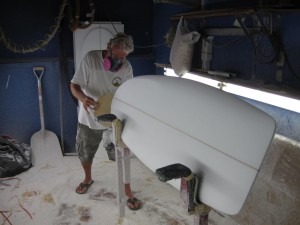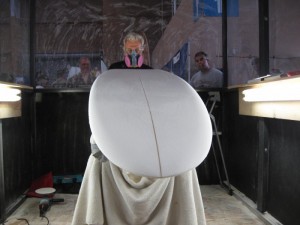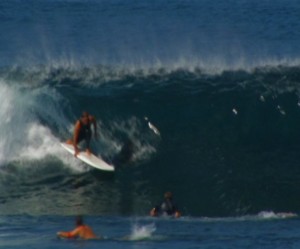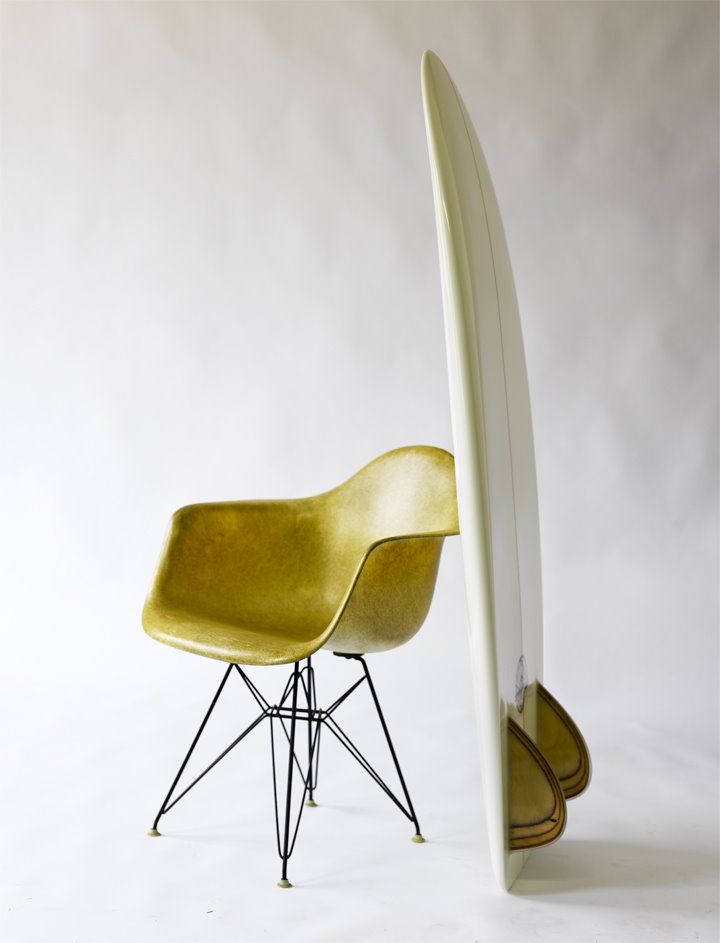Mini Simmons
Mini-Simmons by Joe Bauguess
This is the story of how I designed and created the first original, Mini Simmons Surfboard or Planing Hull.

Original Mini Simmons by Joe Bauguess
A small group of men were gathered around what appeared to be a badly termite-eaten and severely weathered, surfboard-shaped piece of driftwood. One of the guys from the group said “It’s an original Simmons”, so I asked how he knew that to be true.
I hadn’t yet been introduced to John Elwell who then proceeded to tell the story behind the tattered remains of the relic original Simmons. He said he had boards made for himself and his girlfriend by Bob Simmons to take to Hawaii in 1950 and this was her 9 footer. Mr. Elwell mentioned that his board had been 11 feet long and that its whereabouts were unknown.
He told a story of how this board had been dinged and damaged over the years and the old fiberglass had been stripped off with the intention to repair the wood and reglass it. The board spent the next 20 or so years after that under a house on the North Shore of Oahu and became food for the termites.
It was late September 2001 shortly after the 9-11 tragedy, and the mood, even at Mike Eaton’s busy surfboard/paddleboard shop, was somber. Mike was telling John that he just didn’t have the time it would take to rebuild and restore the old Simmons so I volunteered. John Asked, “and who are you?” I told him my name was Joe Bauguess, the surfboard shaper at Eaton’s and that I had the experience to do the restoration. So began “the Simmons project”.
After about 3 weeks, the wood work was complete and the rebuilt balsa wood blank was sent to the fiberglass shop and Mr. Elwell was pleased and asked me to shape a foam replica of the original Simmons board and have it painted “falsa” to give it the look of the real thing.

Original Mini Simmons by Joe Bauguess
Gary Bond, ex-crew chief for Mario Andretti and Eaton’s all around shop guy who does the glass work, welding,and machine work, liked the idea and ordered one to try in the surf. Richard Kenvin was introduced to me by John Elwell as the one who rode the replica I shaped for him. A few years later, Richard commissioned me to build him a solid balsa wood replica. John was kind enough to leave his original heirloom with me to take templates and numerous measurements from, and repeated visual and tactile reminders to assist me in the quest for precise duplication.
I invited John to critique the finished shape and he regaled us with Simmons’ anecdotes and entertained us with impressions of his old pal’s cynical ways of expressing himself, his (Simmons) eccentricity and his scientific approach to surfboard design.
John mentioned, in passing, that Simmons had built at least one 6′ stand-up surfboard. The details, or lack thereof, as recalled by John, were vague recollections of a distant, undocumented past,but the mental image they conjured were enough stir our imaginations. If creation is where thoughts and ideas begin to segue to the physical by means of words and blank orders, this is the time in space of the creation of the “Mini-Simmons.
The actual shaping process began with a solid block of styrofoam 6’X 2’X 5” that resembled a box with a stringer through it, donated to the cause, along with the “Midget Coffin Project” inscription emblazoned on it by the darkly humorous glue-up crew at the foam factory.
I wanted to simulate a balsa blank common to the era and use some of the parameters used in the longer Simmons boards with regard to plan-shape and rocker. By the time the plan-shape was cut out, I realized how light the board was going to be and how it seemed the right time to meld the old into the new. Nostalgia is cool and I’ve shaped all the old-timey designs but NOW is what IS.
So I told Richard my ideas about dropping the rails with a lot of hard edge in the tail section and using a Simmonsesque, rounded nose contour developing into a semi-severe single concave under the fore- mid-section that flows into a double-concave that is deep enough to form a slight vee through the tail section before coming to a flat edge. Speed and release are the theories behind this design. He was in agreement that since it was 2006, we should go for advancing the basic design. Richard was also adamant about keeping some of Simmons’ “signature” touches intact, like the dished out deck in the nose area (originally designed to lighten the nose) and the flowing, “S”- curve deck line.

Original Mini Simmons by Joe Bauguess
All of the board sports that I am actively involved with have been moving in the direction of shorter and wider, and in the
case of kite boards and wake boards, thinner, Windsurfing boards have been evolving shorter and wider for nearly 10 years and more recently, the high wind/ performance sailboards have been changing to more compact dimensions while retaining the same volume. So, perhaps, now is the time for surfboards to follow suit. As it goes with evolution, it will be “discovered” by many people in different places at around the same time.
Mike Eaton, who attended classes in Naval Architecture told me the formula for the most ideal and efficient planing hull was that its length is two and a half times its width, for example; 24″X 60″. The Mini-Sims I’m shaping nearly fit that template as they measure 23″X 66″ for 5′ 6″ board. The result is a board that paddles like a long board and has the maneuverability of a short board.
This may be one of the things that advances surfing to the next plateau and I’m certain that the more its explored, the more it will morph into realms as yet unknown today in wave-riding. We borrow from the past and add the present to create the future…

The Original Mini Simmons

The Original Mini Simmons by Joe Bauguess
